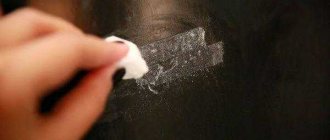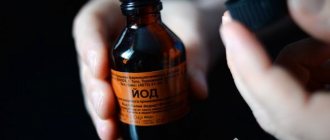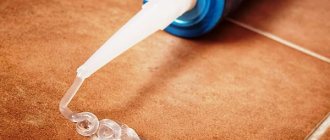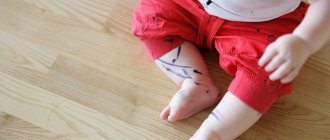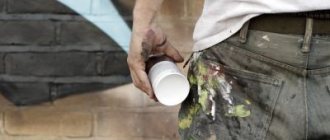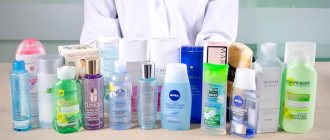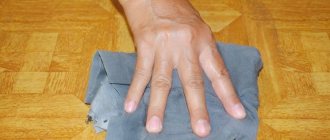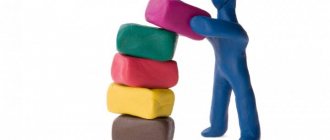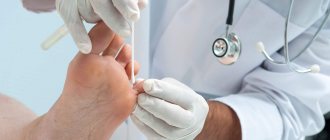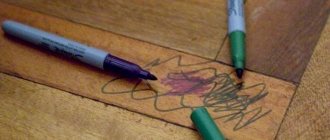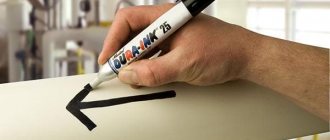The plastic pieces contain wax, paraffin, dyes and fats. It’s not difficult to get rid of a colored stain; the main problem is a greasy stain that will make mom work hard.
In this article we will tell you how and with what you can remove plasticine from wallpaper, carpet, table, skin and hair, and toys.
General rules for removing plasticine
Having discovered pieces of plasticine on clothes or other surfaces, some people resort to improvised methods to eliminate them. And they do not always help to wash away plasticine traces; sometimes with their help you can only aggravate the situation:
- Do not try to wipe off lumps with a dry or damp cloth, as this will only increase the area of contamination.
- If you intend to use products containing alcohol or any detergents, you first need to test their effect on a small area of the soiled material.
- Under no circumstances should you remove plasticine lumps from your hair with your hands. This can only spread the mass along its entire length.
- And you should not wash the stain without pre-treatment, otherwise you can completely ruin the item.
- There are several ways to remove this material from various surfaces. But they all start from the same stages.
- At the beginning of work, you should remove lumps using a stack, which comes standard with plasticine.
- After mechanical impact, you need to clean the oily trace.
- And at the end of the work, clean the surface in any convenient way.
While practicing with plasticine, children sometimes cover up toys with it.
Like other stains, traces of modeling compound are easier to clean while they are fresh and not ingrained into the surface. But this does not always work out, since during the game children can stick colorful lumps in the most unexpected places, give them a variety of shapes, but they cannot be detected immediately. Toys, tables and cabinets are especially affected.
Plasticine includes wax, paraffin, and special clay. It contains synthetic ingredients that make scrubbing easier. But the problem still remains, and you can solve it by following a few simple steps:
- The flat surface should be cleaned with a knife or scraper, removing large lumps. Scrape off the residue without pressing hard so as not to scratch the object. Do not wipe the plasticine with a damp cloth, otherwise it will be smeared on the plastic and the area of contamination will increase.
- Small toys should be immersed in a bowl of hot water for a few minutes, large toys should be heated with a hairdryer. Then collect the remaining melted plasticine with a napkin, moving from the edge to the center of the spot. Wipe the surface with a cloth soaked in the selected product.
- Soiled dolls with fabric inserts should be placed in the refrigerator or cooled with a piece of ice. The frozen mass becomes fragile, it is easier to wipe it off the surface and pick it out of the cracks.
Finish cleaning with washing. Wash large plastic items by hand, put small ones in a special bag and load them into the machine.
Any product must first be tested on an inconspicuous area. Apply a small amount and make sure it does not break down the material or detract from the colors.
How to wipe plasticine off the table
The working area for future plasticine masterpieces always gets dirty first. To keep your furniture looking beautiful, we will share several effective methods.
- Under no circumstances should plastic furniture be heated with an iron or hairdryer. Plastic is a very sensitive material. Even if you remove the plasticine, the stain will still remain. It’s better to take something cold out of the refrigerator and apply it to the problem area on the table. Then scrape off the frozen plasticine with a thin, blunt object. Rinse the table with warm water and wipe the work area with a dry cloth.
How to wipe plasticine off the table
- A wooden table can be revived with vegetable oil. Wet plasticine stains or dried lumps with vegetable oil. Let the oil and plasticine soak for 5 minutes, then carefully remove the Velcro with dry wipes. Wash the table with warm water.
- If there are stains from art left on the table, you need to treat them additionally . Take hydrogen peroxide, moisten a cotton pad with it, and degrease the stains. Then wipe the traces of the plastic mass with alcohol or vodka, the greasy stains will disappear.
To ensure that the table suffers from plasticine captivity as little as possible, buy a protective film or a special board for modeling for the table.
Stain removal steps
Plasticine is a material for creating three-dimensional or flat figures using modeling; it is made from high molecular weight polyethylene, polyvinyl chloride and various types of rubbers.
It is thanks to this composition that traces of creativity on different surfaces have one characteristic feature: removing the mass itself is not difficult, but getting rid of the greasy stain after it is quite problematic. Moreover, the material heats up very quickly (even from body temperature!) and begins to spread over the surface. Due to dyes, greasy stains acquire corresponding shades, which also complicates the process of removing them.
Whatever type of surface we are talking about, the first two stages will be the same for everyone.
- Mechanically remove the lump of mass.
To remove the lump, use the stack that comes with the plasticine. - Cleaning off the oily residue.
- We clean the surface in a suitable way (wash, wash, clean, etc.).
We suggest you familiarize yourself with the best way to clean the car interior with your own hands.
How to remove mass
There is only one removal principle - mechanical. But the algorithm of actions will be different.
Clean toys
To clean plasticine stains from toys made of plastic, simply wipe them with a regular damp cloth. If they are not at hand, soak a cotton pad in vegetable oil, treat the soiled surface, and then wash with soapy warm water.
Soft fabric toys are cleaned using a paste of laundry soap, ammonia or medical alcohol, and kerosene.
Selecting tools for removing plasticine
The most convenient way to remove plasticine from a flat surface is with a scraper.
If after children's activities a sticky lump is found on a hard surface, you can remove it in several stages, each of which uses its own tools. You will need to scrape off the top first. This is done with a plastic knife, scraper, or any flat object with a smooth edge, such as an old bank card.
To wash plasticine from plastic with an uneven and textured surface, take a brush with medium-hard bristles. You can rub it with a kitchen sponge, but don’t try too hard, otherwise the plastic will be scratched or the paint will peel off.
To remove remaining stains, you need rags, napkins, sponges, which are used for applying special compounds for washing and wiping. They must be soft, always clean, and absorb moisture well. It is convenient to work with cotton pads and rags made of natural fabrics and microfiber.
Freezing method
The opposite way to wipe off plasticine: exposure to cold. If you cover the contaminated area with ice, the plasticine will freeze. All you have to do is carefully pry it off with a knife or blade. No ice - add crumbly frozen product. Pieces of vegetables or berries from the freezer will do.
A greasy stain will remain, which can be removed according to point No. 4 (see above)
This method is suitable for wallpaper, carpet, table, linoleum.
If the goal is to wash plasticine from the surface of the carpet, at the final stage, comb the pile with a brush and thoroughly clean off the ice-hardened pieces of plasticine. You may need to use a carpet cleaner.
How not to do it
Before dwelling on specific methods for removing stains left by plasticine, it is worth making a few cautionary recommendations.
- In order not to increase the area of the stain, there is no need to try to wipe it off.
- Before using alcohol, stain remover, or detergents, you must try them on an inconspicuous area of the material being treated (fabric, carpet, wallpaper, etc.).
- If plasticine ends up in the creator’s hair, then under no circumstances should you remove these lumps with your hands: the mass melts and “scatters” throughout the entire head of hair.
- An attempt to remove a trace without pre-treatment will not be successful a priori.
Simply washing the item is not enough to remove plasticine stains.
Remove from carpet
Before cleaning the surface of the carpet from plasticine, you need to:
- apply an ice cube to the stuck piece, wait until the mass hardens;
- Use a stack or plastic spatula to scrape frozen plasticine from the carpet;
- remove the nozzle from the vacuum cleaner pipe, put an old sock on it;
- vacuum up small residues, remove the sock and throw away.
After this, you need to clean the carpet from traces of the colored mass. The cleaning method is selected based on the area of contamination and the type of carpet. If the stain is small, you can cut off the dirty fibers with scissors. For large stains, use the same method as for wallpaper: place blotting paper on the stain and iron it with a hot iron. They change the paper to a new one and iron it again. Continue until the marks disappear.
Important! This method is not suitable for products made of synthetic fibers - they will melt upon contact with a heated sole.
A stain remover, solvent or nail polish remover will help remove plasticine residues from the pile. After treatment, you will need to wash the carpet with a soapy sponge.
Folk remedies for removing plasticine from toys
It is enough to wipe dolls, cars, etc. with wet wipes or, if there are no wipes in the house, use a cloth with vegetable oil and then wash the item in soapy water. Or simply wipe off the remaining plasticine with a napkin. Soft toys are cleaned in the same way as other textiles. That is, you need to take into account the color and texture of the material. Finally, large characters are washed by hand, and small ones are machine washed, but in a special laundry bag.
Dolls, plastic and plastic toys can be cleaned in the same way as other items made from similar materials, but it is better to wash soft ones after removing stains.
To properly wash plasticine from plastic, any preparations should be used after mechanical cleaning. Even the most effective composition will not cope with a thick layer of sticky and dense mass. The task of chemistry is to remove residues, remove greasy stains, and lighten colored areas. For these purposes, many effective and safe drugs have been invented:
- Detergents and bleaches. They break down fat well and cope with stains from Fairy, Frosch, Pril dishwashing liquids. They can be dissolved in water to remove plasticine from toys, or applied directly to the stain with a sponge. After a few minutes, rub a little and rinse with water. For light, unpainted objects you can use Vanish. Easy to use and effective is the universal LOC preparation from Amway, safe for various materials, offered in the form of wet wipes, spray or concentrate.
- Solvents based on kerosene, white spirit or acetone. Simply wipe the stain with a cotton pad soaked in the substance and rinse off after 15 minutes with water. The advantage of this method is high efficiency and speed. But it is not suitable for all materials. These products are too caustic and require careful handling. When working, be sure to use gloves.
- Cooling agents. Try spraying Icemix, Anti-gum, Pramol Gumex sprays on the plasticine. The temperature of the adhered mass decreases and its elasticity decreases. After a few minutes, you can simply pick out the lump.
- Automotive chemistry. Many products created for caring for plastic in car interiors are successfully used at home. Multifunctional M1 Cleaning Polish, Cockpit-Spray, Plastic Cleaner clean, give an antistatic effect, have a pleasant smell, and create a protective film.
Suitable for white and light-colored items Cleans and creates a protective film Anti-gum freezes plasticine We suggest you read How to bleach white things at home: folk recipes and chemistry
Liquids should not contain caustic or aggressive components, given that products are used for children's furniture and toys.
A mixture of ammonia and peroxide quickly dissolves plasticine
There will definitely be ingredients in your home to prepare effective and affordable medications. They are always at hand, inexpensive, and gentle on the surface. They do not leave harmful or allergy-causing particles.
Here are some recipes:
- Laundry soap. Grate a small piece and dissolve the shavings in warm water. Use pre-soak and hand wash solution. Dip a rag into it and wipe away any traces of plasticine.
- Vegetable oil. This is a simple and quick method suitable for cleaning toys. Dampen a sponge or rag in the product and wipe the contaminated areas. Repeat the procedure until there are no traces of children's creativity left. The fat is removed with a dry blotter and washed off with detergent.
- Ammonia with hydrogen peroxide. Prepare a mixture by combining equal amounts of these liquids. Rub the plasticine slightly heated with a hairdryer with the resulting composition, applying it to a sponge. Leave for a few minutes, remove with a dry cloth, rinse with warm water. This will get rid of the greasy mark and whiten the color stain.
- Gruel for removing fat. Plastic is cleaned well by a mixture that includes vinegar, soda and detergent. When applying it, you do not need to rub it hard so as not to leave marks.
- Baking soda. Combine this powder with water in a 1:1 ratio, apply the resulting paste to a plastic figurine or machine, rub in, cleaning all the unevenness and roughness, and rinse.
For children's things, preparations prepared independently are more preferable, since they contain fewer aggressive and caustic components.
How to remove from a hard surface?
Of course, the best option is when you get by with little damage and all you need is to simply wash the plasticine off the wood, glass or plastic. For example, if a table, toys or special children's boards for modeling were smeared with it. This process will not take much time and effort. So, to erase plasticine from toys or boards, it will be enough to take hot water into a wide container and place the contaminated objects there for a few minutes. The material will quickly melt, and you can easily scrape off its remains with a plastic knife or an alternative that you have on hand, for example, an old plastic discount card. Afterwards, it is enough to wipe the item with a clean cloth soaked in a soap solution or a mixture of ammonia and hydrogen peroxide (in a ratio of 1 to 1).
With the table, the actions are practically repeated. Prepare a warm soapy solution, wet the stained area and carefully remove it with a sponge and scraper. Do not scratch wood or glass surfaces. If the plasticine does not come off the table immediately, try heating the defect with a hairdryer, this will make it more manageable and you can again use a sponge with soapy water.
Professional approach
Grease stains from plasticine can also be removed using industrial means. Such as:
- Antipyatnin soap;
- stain removers Amway, Faberlic;
- whitening soap "Maxima" (for white clothes).
Maxima laundry soap does an excellent job of removing any stains on white fabric, including greasy marks from plasticine.
Their use must be coordinated with the type of fabric from which the item is made.
How to remove a fresh stain?
Before the plasticine has time to melt and penetrate deep into the surface structure, it must be removed. The primary task is to get rid of the colored cake in any way possible. It can be heated to gently peel it off using paper, or frozen.
You should not try to scrub the stain, this will worsen the problem and increase the area of contamination.
The next stage is to eliminate the greasy trace from the plastic mass. Here you can use any product from the housewife’s arsenal:
- soda;
- ammonia;
- laundry soap;
- dishwashing liquid;
- stain remover
You need to choose a method for cleaning the surface taking into account the material from which the item is made.
Prevention of plasticine contamination
Buy plasticine for children that does not stick to the surface and does not leave stains.
Keep a close eye on your baby while playing with plasticine. This is necessary not only to maintain cleanliness, but also for safety. This way you can prevent foreign objects from entering your body. Practice modeling with your child and explain how to handle this material. At the end of the game, help him collect and put in their places all the objects used for creativity.
Set aside a special corner for activities, buy special clothes for modeling and drawing, in which the baby will be comfortable. Accustom him to order, teach him to fold plasticine separately from other things. Ask to speak immediately if pieces are stuck to walls, floors, furniture or toys so that they can be removed as soon as possible.
Play-Doh sets do not stick to hands and surfaces and are easier to clean. If, after playing, an unnoticed piece gets stuck somewhere, it will dry and fall off the next day, leaving no stains on the plastic. Their only drawback is the high price, but compared to safety and ease of use, it turns out to be insignificant.
Almost all methods for removing plasticine are applicable and effective. You can try several of them, starting with the gentlest one. When using them, it is important not to damage the coating and thoroughly rinse off the product so that no substances hazardous to health remain on objects that children will come into contact with.
Plasticine is a material that, due to its malleability, can take any shape. For its production, high molecular weight polyethylene, polyvinyl chloride and some types of rubber are used. All these components have the ability to leave greasy spots on various surfaces. It turns out that removing the plasticine itself will not be difficult, but removing greasy stains is problematic.
A few years ago, plasticine mass was made from clay powder, animal fats and substances that helped the material not dry out. And this, in turn, made it more stable, which made the process of removing it more difficult. Now any surface can be cleaned of plasticine so that absolutely no traces remain.
We suggest you read: Which fabric is better for bed linen: what to buy, reviews
Why is it so difficult to get rid of traces of plasticine?
At room temperature, plasticine remains soft. You won’t be able to scrape it off with your nails or the blunt side of a knife: it smears over the surface or penetrates into the fibers of the fabric. There are greasy stains that also have to be removed. Plasticine owes these properties to its composition. It includes purified crushed clay, wax or paraffin, animal fats and dyes. Thanks to fats, it does not harden and leaves your hands feeling a little greasy after sculpting. Dyes stain surfaces and, after friction, penetrate into the top layer of the material.
Plasticine is the easiest to remove from hard objects. The situation is much more complicated with carpets, upholstered furniture, toys and clothing. It is also not easy to remove it from wallpaper, especially paper wallpaper. Fortunately, there are effective methods that will help get rid of this problem without harming the soiled items.
Modeling from plasticine is a fun activity for a child
Features of removing plasticine from wallpaper
Sometimes a child’s creative impulse can be so strong that even wallpaper ends up in the modeling material, that is, plasticine. This is a very inconvenient surface from a cleaning point of view.
Heating plasticine is quite dangerous - it will spread over a large area, so this method can be used when there are no longer lumps on the wall.
Instructions:
- Direct a stream of hot air onto the stain.
Removing traces of plasticine using a hairdryer is convenient, although it requires patience - Periodically wash off the melted plasticine with a thin cloth.
Tips for parents
You can avoid problems with plasticine sticking if you use some simple tips:
- Set aside a special place for creativity.
- Provide your baby with clothes that you don’t mind getting dirty.
- Do not leave the child alone while sculpting.
- After playing, remove materials and instruments to a specially designated storage area.
There is an option for “lazy” parents - buying plasticine in plastic containers. It does not leave stains, does not stick to surfaces and dries with prolonged contact with air. It has disadvantages - a short period of use and the price is much higher.
Cleaning textiles
If the plasticine mass has stuck to the fabric and has been on it for quite a long time, then it can be removed without much effort. To do this, you will need a stack or the blunt side of a knife, which you can simply use to pry off the lump. A razor and the sharp side of a knife are not suitable for this purpose; they can damage the product.
You can try removing the plasticine with an iron. In this case, you will need to take two thick white sheets of paper. One of them should be under the stain, and the other should cover the contaminated area. After this, you need to slightly heat the iron and iron the sheet several times. These manipulations will allow you to glue the plasticine to the paper. Sheets of paper are changed until the fabric surface is completely clean.
If you use laundry soap for business, you first need to cut off a small piece of it and grate it. The resulting chips must be dissolved in warm water until foam forms. Then the dirty item is placed in the container and additionally rubbed with soap. After half an hour, all that remains is to wash the item. The good thing is that laundry soap is universal and suitable for any fabric.
To use baking soda, the grease stain must be soaked in soapy water beforehand. Then pour soda on it, rub it and let it soak for half an hour. After time has passed, the stain is carefully treated with a brush and washed in the usual way. But you cannot use water below or above 60 degrees for this method, and you cannot wash synthetic fabrics in this way.
Ammonia works well on dirt formed on natural fabrics. To remove greasy marks, you will need to dilute five drops of alcohol in 100 ml of water. Then take a cotton pad, moisten it and wipe the greasy area until it disappears completely. After the procedure has been completed, all that remains is to wash the item. If the stain is large, then the proportions of ammonia and water increase in equal progression.
If vegetable oil and detergent are used to remove greasy stains from toys or clothes, then you need to take a rag soaked in vegetable oil. Then wipe the fat with this napkin until it disappears completely. You need to finish the procedure with a detergent, which is applied to the fabric for 40-60 minutes, and then simply wash it.
Kerosene is often used to remove plasticine traces. It cleans textiles well, but leaves behind a specific smell. Therefore, after removing the stain, you will have to wash the item thoroughly.
The most effective method is to use industrial stain removers. In order for them to help solve the problem, you just need to follow the instructions on the package.
Ways to clean clothes
Plasticine heats up easily and adheres firmly to the fabric. If you do not clean the plasticine from your trousers and immediately throw them in the wash, the dirt will not be completely removed. First you need to try to remove the substance from clothing as much as possible.
Cooling
When exposed to low temperatures, the substance hardens quickly, and in this form it is easy to separate from the fabric. To remove plasticine from clothes, you can place them in the freezer if their size allows. Allow time for the adhering plasticine to become hard and brittle. After this, you need to pry it off and scrape it off. A thick layer will easily crumble and fall off.
Advice! If it is not possible to place the product in the freezer, you can apply a dry ice pack to the problem area.
The freezing method is quite effective. It is also used to remove foam and chewing gum.
Heat
You can also clean clothes using heating. Here, on the contrary, you should warm up the plasticine. The product is laid out on an ironing board, and plasticine spots are covered with paper towels. The iron is heated and pressed tightly onto the towel. The melted plasticine will be absorbed into the paper fibers. The manipulation is repeated several times.
Heating is effective for denim, cotton and other dense fabrics. They can easily withstand high temperatures. Silk, wool, organza, guipure, polyester, lycra can be easily damaged. In this case, you cannot heat the iron higher than the temperature at which it is recommended to iron such things.
Method with homemade stain remover made from soap and soda
A solution of soap and soda is an easy way to remove plasticine from delicate trousers. Heating, using kerosene and alcohol can damage clothes, but a homemade stain remover leaves no traces behind.
How to delicately clean fabric:
- Remove plasticine using any mechanical method. You can resort to freezing or scraping off the material with your finger or a mild knife. Heating is not recommended: on natural fabrics, greasy stains are even more noticeable.
- There will be greasy stains on the fabric, and possibly small particles of plasticine. A mixture of soap and soda will help deal with just such stains. You need to grind a small piece of laundry soap and dissolve it in hot water.
- Apply the solution to the stained area. Wait 20 minutes: the soap should saturate the fabric and begin to break down fats.
- After the required time, sprinkle baking soda on the stained area of clothing. It will absorb the remaining fat and remove the dye from the plasticine if it has left streaks. Wait another 15 minutes.
- Place clothes in the washing machine for 30 minutes. You need to set the delicate or manual mode.
You can wash clothes by hand by filling a basin with water at a temperature of no more than 60 degrees. The advantage of baking soda and soap is that this solution removes any stains in just 30 minutes without corroding the original dye of the fabric.
It is best to use baking soda and soap in conjunction with other cleaning methods. This is an ideal option for removing stains after the plasticine itself has already been detached from the fabric. Soda and soap are used after freezing or heating the plasticine with an iron. This stain remover works well to remove residues of ammonia or isopropyl alcohol, which are often used to remove sticky and greasy substances. Another advantage of the soda composition is that it is absolutely safe for children even under 3 years old. If your baby gets his clothes dirty, you can safely wash them with a homemade stain remover.
Vegetable oil
This method is suitable for any fabric and is considered one of the most effective in the fight against sticky stains. To remove plasticine from clothes, you must:
- soak a cotton swab with oil;
- wipe the dirty area with it (do this for 2 minutes);
- after the oil reacts with the fats in the plasticine, the stain will dissolve;
- the remaining greasy trace should be treated with dishwashing detergent and left for an hour;
- Next, rinse the clothes with water.
